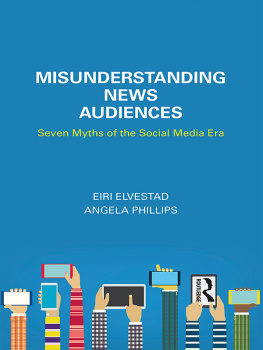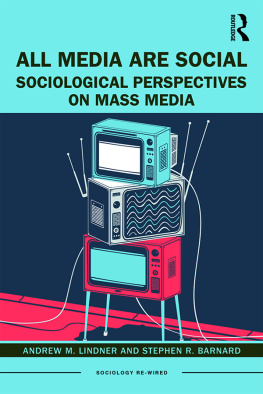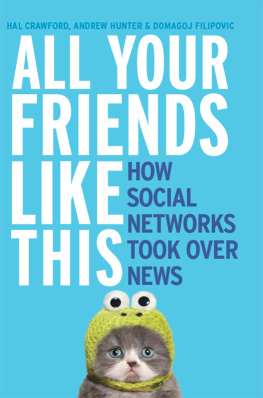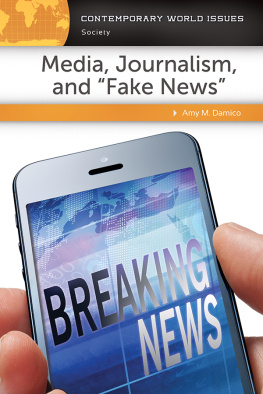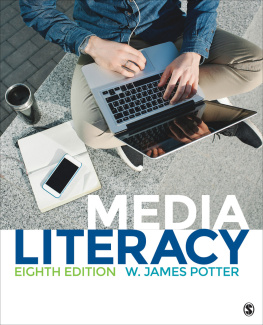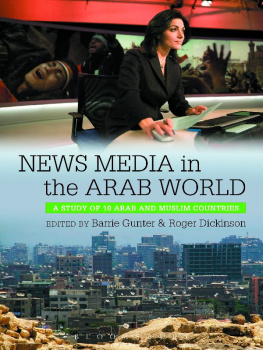The World News Prism
Digital, Social and Interactive
Ninth Edition
William A. Hachten
and James F. Scotton
This ninth edition first published 2016
2016 John Wiley & Sons, Inc
Edition History: Iowa State University Press (1e, 1981; 2e, 1987; 3e, 1992; 4e, 1996; 5e, 1999; 6e, 2002); Blackwell Publishing Ltd. (7e, 2007); John Wiley & Sons, Ltd (8e, 2012)
Registered Office
John Wiley & Sons Ltd, The Atrium, Southern Gate, Chichester, West Sussex, PO19 8SQ, UK
Editorial Offices
350 Main Street, Malden, MA 02148-5020, USA
9600 Garsington Road, Oxford, OX4 2DQ, UK
The Atrium, Southern Gate, Chichester, West Sussex, PO19 8SQ, UK
For details of our global editorial offices, for customer services, and for information about how to apply for permission to reuse the copyright material in this book please see our website at www.wiley.com/wiley-blackwell.
The right of William A. Hachten, James F. Scotton to be identified as the authors of this work has been asserted in accordance with the UK Copyright, Designs and Patents Act 1988.
All rights reserved. No part of this publication may be reproduced, stored in a retrieval system, or transmitted, in any form or by any means, electronic, mechanical, photocopying, recording or otherwise, except as permitted by the UK Copyright, Designs and Patents Act 1988, without the prior permission of the publisher.
Wiley also publishes its books in a variety of electronic formats. Some content that appears in print may not be available in electronic books.
Designations used by companies to distinguish their products are often claimed as trademarks. All brand names and product names used in this book are trade names, service marks, trademarks or registered trademarks of their respective owners. The publisher is not associated with any product or vendor mentioned in this book.
Limit of Liability/Disclaimer of Warranty: While the publisher and authors have used their best efforts in preparing this book, they make no representations or warranties with respect to the accuracy or completeness of the contents of this book and specifically disclaim any implied warranties of merchantability or fitness for a particular purpose. It is sold on the understanding that the publisher is not engaged in rendering professional services and neither the publisher nor the author shall be liable for damages arising herefrom. If professional advice or other expert assistance is required, the services of a competent professional should be sought.
Library of Congress Cataloging-in-Publication Data
Hachten, William A.
The world news prism : digital, social and interactive / William A. Hachten, James F. Scotton. -- Ninth edition.
pages cm
Summary: Fully revised new edition of a well-respected treatise on the changing role of transnational news media in the 21st-century-- Provided by publisher.
Includes bibliographical references and index.
ISBN 978-1-118-80904-4 (paperback)
1. Foreign news. 2. Communication, International. 3. Digital media. 4. Mass media and globalization. I. Scotton, James Francis, 1932 II. Title.
PN4784.F6H3 2015
070.4332--dc23
2015015812
A catalogue record for this book is available from the British Library.
Cover image: Original reference map taken from NASA Vertigo3d / iStockphoto
To the many journalists around the world who have been killed,
kidnapped, or jailed for reporting the news
Contents
Guide
Pages
Notes on Contributors
Rasha Abdulla is Associate Professor and former Chair of the Department of Journalism and Mass Communication at The American University in Cairo (AUC). She has a Ph.D. in Communication from the University of Miami in Coral Gables, Florida. She is the recipient of the AUC Excellence in Research Award for her research on social media and political activism leading to and during Egypt's revolution. She is the author of three books and numerous articles and book chapters. She tweets regularly at @RashaAbdulla.
Natalia Bubnova is an Associate at the Institute of World Economy and International Relations at the Russian Academy of Sciences in Moscow. She was formerly Deputy Director of the Carnegie Moscow Center and Associate Director of the Center for International Studies at Marquette University in Milwaukee, Wisconsin.
William A. Hachten is Professor Emeritus of Journalism and Mass Communication at the University of Wisconsin-Madison, where he taught for thirty years. His publications include The Troubles of Journalism, 3rd edition (2005), The Growth of Media in the Third World (1993), and The Press and Apartheid (with C. A. Giffard, 1984).
Heloiza Golbspan Herscovitz is Associate Professor at the Journalism and Mass Communication Department of California State University, Long Beach, where she teaches Global News Media and other courses. She is a veteran journalist with extensive experience as a reporter and editor in Brazil and has transnational academic experience.
Sandhya Rao is Professor of Journalism and Mass Communication and Honorary Professor of International Studies at Texas State University. She taught in India as a Fulbright Scholar and has edited Cyberpath to Development in Asia Issues and Challenges and Critical Issues in Communication: Looking for Answers.
James. F. Scotton is Associate Professor of Journalism at Marquette University, Milwaukee. He has taught in Lebanon, China, Egypt, Uganda, Kenya, and Nigeria. He has worked as a correspondent in Washington DC, as a reporter and editor with the Associated Press, and with newspapers in California, Wisconsin, North Carolina, and China.
Together James Scotton and William Hachten are the authors of New Media for a New China (Wiley-Blackwell, 2010).
Preface to the Ninth Edition
Why another edition of The World News Prism? The answer is pretty much the same as before. The phenomenon of international news continues to evolve and change in many ways mostly because of the ongoing digital revolution in communication media.
The Internet, which has spawned the digital age, was not predicted. Just over twenty-five years ago the net caught the world by surprise and further surprises keep tumbling out. Now, in the second decade of the twenty-first century, the number of earthlings connected to the Internet has increased from 350 million to more than 2 billion worldwide. During this same decade, the number of mobile phone users rose from 750 million to well over 5 billion in the world. (It is now estimated at about 6 billion.)
Eric Schmidt and Jared Cohen, both with Google, have predicted that by 2025 the majority of the world's population will have gone from virtually no access to information to unfiltered access to almost all the information in the world. If the current pace of growth is maintained, they say, most of the nearly 8 billion people on earth will be online by 2025.
In this ninth edition we will describe and analyze how the ways of gathering and disseminating global news and information have been expanded (and complicated) by the increasing role of the so-called social media. Twitter, Facebook and other platforms that provide photos, videos and other posts will be looked at, and also the blogosphere that supports and enhances the flow of news.
This ninth edition includes new or revised chapters on media systems in regions outside the orbits of the United States and western Europe. We have recruited media specialists for appraisal of media in Brazil, India, Russia and the Middle East. The world's media look different from Rio de Janeiro, New Delhi, Moscow and Cairo than they do from New York or London. But no matter where people live in the world, most news or public information is local. People care about what happens in their community, their country, their part of the world. Yet in today's interconnected and globalized world people everywhere easily learn about and are affected by news about civil wars, civil strife, terrorist attacks, economic upheavals and great catastrophes, even tsunamis and epidemics, that occur far from home. More than ever before in history, more people are both informed and have opinions whether about globalization, terrorist warfare, nuclear proliferation or the ominous threat of climate change. The onrush of digital communication the Internet, social media, cellphones, computers has made this possible.



